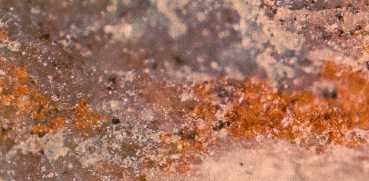the john muir exhibit - science - muirite
Muirite:
A barium mineral from Fresno County, California
Photo and text by John T. Alfors and Melvin C. Stinson

Muirite is essentially a basic barium calcium titanium silicate with chlorine. It occurs as tiny orange grains up to 1 mm long disseminated in sanbornite-quartz rock. Aggregates of grains range up to 3 mm. the mineral is most abundant at the Big Creek [Fresno County] locality and the accompanying photograph is more or less typical of muirite from that locality.
Although it typically occurs as anhedral grains, tiny euhedral terragonal crystals of muirite can be found with diligent search. The common forms are the base and |100| prisms, but some crystals with |110| prisms and |h01| faces have been observed. The two cleavages (001) and (100), are indistinct. Muirite with a hardness of 2 1/2 is the softest of the new barium minerals. It is generally recognized in hand specimen by its orange color and tetragonal character.
The mineral is named for John Muir (1838-1914), mountaineer, conservationist, and naturalist who made important observations in geology and glaciology in the sierra Nevada in the late 1800's. John Muir was not trained as a scientist, but he was a keen observer of natural phenomena. He was among the first to ascribe the formation of Yosemite Valley largely to glacial excavation at a time when nationally prominent geologists as Josiah D. Whitney, then State Geologist of California, and Clarence King, one of Whitney's assistants and later the first Director of the United States Geological Survey, believed it was formed primarily by faulting. King thought the glaciers had little excavating power and that the valley had been only slightly modified by glaciation, but Whitney went so far as to deny that a glacier had ever invaded the valley.
* * *
An interesting feature of the sanbornite deposits is the presence of so many barium-titanium minerals. Titanium is an essential constituent in muirite.
Source: Mineral Information Service, a publication of the California Division of Mines and Geology, Vol. 18, No. 2 (February, 1965), pp. 27 - 30.
Return to Scientific Names in Honor of John Muir
Home
| Alphabetical Index
| What's New
| Message Board